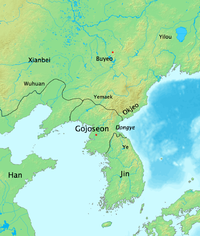

| Wi Man 衛滿 위만 | |
|---|---|
| King of Wiman Joseon | |
| Reign | 194 BCE – Unknown |
| Successor | Unknown |
| |
| House | Wi |
| Wiman of Gojoseon | |||||||||
|---|---|---|---|---|---|---|---|---|---|
| Chinese name | |||||||||
| Traditional Chinese | 衛滿 | ||||||||
| Simplified Chinese | 卫满 | ||||||||
| |||||||||
| Korean name | |||||||||
| Hangul | 위만 | ||||||||
| Hanja | 衛滿 | ||||||||
| |||||||||
| Wiman Joseon monarchs | ||||||
|---|---|---|---|---|---|---|
|
||||||
|
|
Wi Man (in Korean) or Wei Man (in Chinese) was a Chinese military general and monarch. He was originally a military leader of the Chinese Kingdom of Yan.[note 1] When king Lu Wan of Yan was defeated by the Han in 195 BCE, Wi Man fled to Gojoseon in north-western Korea and later usurped power from its king in 194 BCE, establishing Wiman Joseon. Recorded in the Records of the Grand Historian and the Book of Han, Wiman was the first ruler in the history of Korea to have been recorded in documents from the same time period.

After Emperor Gaozu of Han suppressed the rebellion of Zang Tu, king of Yan, he appointed general Lu Wan as Yan's new king. In 196 BC, Emperor Gaozu suspected Lu Wan of plotting rebellion and ordered an attack against Yan. Lu Wan fled to the Xiongnu while his general Wiman (Wei Man) led a thousand followers east to Gojoseon.[1] He was initially ordered to fortify Gojoseon's northwestern border by King Jun of Gojoseon, however with the help of Yan refugees, Wiman usurped the throne (194~180 BCE). King Jun fled to Jin and called himself the "King of Han."
Wiman's capital of Gojoseon was Wanggeom-seong, generally identified as Pyongyang.[2] Since the Han dynasty was not completely stabilized yet, the governor of Liaodong appointed Wiman as an outer subject, provided that he did not prevent natives going up to the empire. The appointment is dated at 191 or 192 BCE.[3] Having superior military strength, Wiman Joseon was able to subjugate the state of Jinbeon (진번, 眞番) and Imdun (임둔, 臨屯), vastly extending its borders. His kingdom was eventually conquered by Emperor Wu of Han in 108 BCE during the reign of Ugeo of Gojoseon.
Wiman of Gojoseon House of Wi | ||
| Regnal titles | ||
|---|---|---|
| Preceded by | King of Gojseon 194 BC – c. 161 BC |
Unknown Next known title holder: Ugeo |